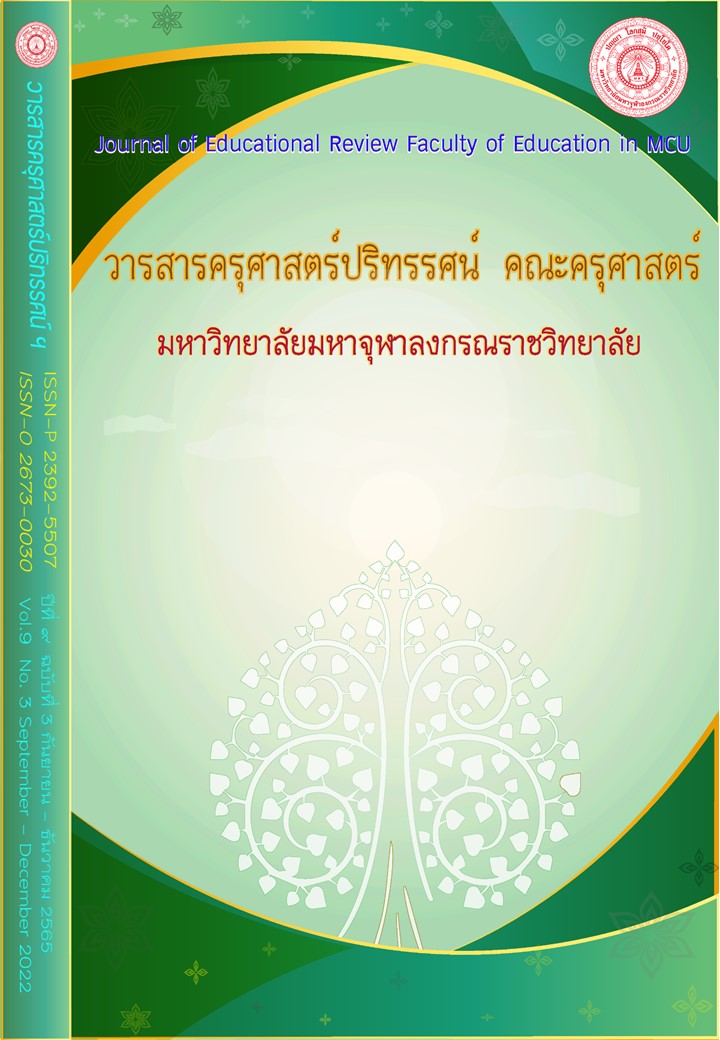การใช้เครื่องมือออนไลน์เพื่อพัฒนาทักษะการอ่านภาษาอังกฤษ
Main Article Content
บทคัดย่อ
บทความวิจัยนี้มีวัตถุประสงค์เพื่อ 1) เปรียบเทียบผลคะแนนก่อนเรียนและหลังเรียนโดยใช้เครื่องมือออนไลน์ในวิชาการอ่านภาษาอังกฤษเบื้องต้น 2) ศึกษาความพึงพอใจของนักศึกษาสาขาวิชาภาษาอังกฤษ ระดับชั้นปีที่ 1 ที่มีต่อการจัดการเรียนรู้โดยใช้เครื่องมือออนไลน์ และ 3) ศึกษาความพึงพอใจของนักศึกษาสาขาวิชาภาษาอังกฤษ ระดับชั้นปีที่ 1 ที่มีต่อเครื่องมือออนไลน์ ทั้งด้านเนื้อหา ด้านการออกแบบและการจัดรูปแบบ และด้านประโยชน์และการนำไปใช้ กลุ่มตัวอย่างที่ใช้ในการศึกษาเป็นนักศึกษาสาขาวิชาภาษาอังกฤษ ชั้นปีที่ 1 ซึ่งได้มาโดยวิธีการสุ่มกลุ่มตัวอย่างแบบแบ่งกลุ่ม จำนวน 25 คน เครื่องมือที่ใช้ในการวิจัยได้แก่ แผนการจัดการเรียนรู้ เว็บไซต์ของมหาวิทยาลัยต่างประเทศที่มีเนื้อหาเกี่ยวกับทักษะการอ่านภาษาอังกฤษ จำนวน 10 เรื่อง ใบแสดงหัวข้อการเรียนรู้ผ่านเว็บไซต์ (Learning through Website List) ที่แสดงการเข้าถึงและเชื่อมโยงไปยังเว็บไซต์ของมหาวิทยาลัยต่างประเทศ ใบงาน แบบทดสอบทักษะการอ่านก่อนเรียนและหลังเรียน แบบประเมินความพึงพอใจต่อการจัดการเรียนรู้โดยใช้เครื่องมือออนไลน์ และแบบประเมินความพึงพอใจต่อเครื่องมือออนไลน์ ด้านเนื้อหา ด้านการออกแบบและการจัดรูปแบบ และด้านประโยชน์และการนำไปใช้ มีสถิติที่ใช้ในการวิเคราะห์ข้อมูล ได้แก่ ค่าเฉลี่ย และการทดสอบค่าสถิติ t-test ผลการวิจัยพบว่า 1) ผลคะแนนทางการเรียนของผู้เรียนหลังการใช้เครื่องมือออนไลน์สูงกว่าคะแนนก่อนเรียนอย่างมีนัยสำคัญทางสถิติที่ระดับ p-value 0.009 2) ความพึงพอใจของกลุ่มตัวอย่างต่อการจัดการเรียนรู้โดยใช้เครื่องมือออนไลน์ในภาพรวมอยู่ในระดับมาก คิดเป็นค่าเฉลี่ย 3.49 3) ความพึงพอใจของกลุ่มตัวอย่างต่อเครื่องมือออนไลน์ในภาพรวมอยู่ในระดับมาก ทั้งด้านเนื้อหา ด้านการออกแบบและการจัดรูปแบบ และด้านประโยชน์และการนำไปใช้ คิดเป็นค่าเฉลี่ย 3.18, 3.01, และ 3.66 ตามลำดับ
Article Details

อนุญาตภายใต้เงื่อนไข Creative Commons Attribution-NonCommercial-NoDerivatives 4.0 International License.
ทัศนะและความคิดเห็นที่ปรากฏในบทความในวารสารฉบับนี้ถือเป็นความรับผิดชอบของผู้เขียนบทความนั้นเพียงผู้เดียว และไม่ถือเป็นทัศนะและความรับผิดชอบของกองบรรณาธิการ
กองบรรณาธิการขอสงวนสิทธิ์ในการคัดเลือกบทความลงตีพิมพ์และจะแจ้งให้เจ้าของบทความทราบหลังจากผู้ประเมินบทความตรวจอ่านบทความแล้ว
ต้นฉบับที่ได้รับการตีพิมพ์ในวารสารครุศาสตร์ปริทรรศน์ คณะครุศาสตร์ มหาวิทยาลัยมหาจุฬาลงกรณราชวิทยาลัย ถือเป็นกรรมสิทธิ์ของคณะครุศาสตร์ มหาวิทยาลัยมหาจุฬาลงกรณราชวิทยาลัย ห้ามนำข้อความทั้งหมดหรือบางส่วนไปพิมพ์ซ้ำ เว้นเสียแต่ว่าจะได้รับอนุญาตจากมหาวิทยาลัยฯ เป็นลายลักษณ์อักษร
เอกสารอ้างอิง
กรมวิชาการ. (2550). หลักสูตรภาษาอังกฤษ พุทธศักราช 2551. กรุงเทพมหานคร: ครุสภาลาดพร้าว.
คณะกรรมการการศึกษาแห่งชาติ. (2544). แนวการจัดการศึกษาตามพระราชบัญญัติการศึกษาแห่งชาติ. กรุงเทพมหานคร: สถาบันแห่งชาติเพื่อปฏิรูปการเรียนรู้.
ชวนพิศ ศรีวิชัย. (2549). การใช้กลยุทธ์การเจรจาหาความหมายเพื่อส่งเสริมความเข้าใจในการอ่านภาษาอังกฤษ. วิทยานิพนธ์ศึกษาศาสตรมหาบัณฑิต. มหาวิทยาลัยเชียงใหม่.
นวพล ชลารักษ์. (2558). บทบาทของครูกับการเรียนการสอนในศตวรรษที่ 21. วารสารมหาวิทยาลัยฟาร์อีสเทอร์น. 9(1). 65.
นิคม ทาแดง . (2537). ประมวลสาระชุดวิชา สัมมนาการวิจัยและทฤษฎีทางเทคโนโลยีและสื่อสารการศึกษา หน่วยที่ 5-7. กรุงเทพมหานคร: มหาวิทยาลัยสุโขทัยธรรมาธิราช.
บุญชม ศรีสะอาด. (2548). วิธีสถิติสำหรับการวิจัย. พิมพ์ครั้งที่ 2. กรุงเทพมหานคร: สุวิริยาสาส์น.
ประสาท เนืองเฉลิม. (2558). แนวการเรียนรู้วิทยาศาสตร์ในศตวรรษที่ 21. วารสารพัฒนาการเรียนการสอน มหาวิทยาลัยรังสิต. 9(1). 137.
ผจงกาญจน์ ภู่วิภาดาวรรธน์. (2540). เอกสารประกอบคำสอนกระบวนวิชา 058455 เทคนิคการสอนการอ่านภาษาอังกฤษในระดับมัธยมศึกษา. เชียงใหม่: มหาวิทยาลัยเชียงใหม่.
เยาวภา สงวนวรรณ. (2540). การออกแบบเว็บกราฟฟิกด้วย HTML3.2. กรุงเทพมหานคร: เฟิสท์แปซิฟิค มีเดีย.
โสรญา สมานมิตร และวิสาข์ จัติวัตร์. (2560). แบบฝึกทักษะการอ่านภาษาอังกฤษโดยใช้กิจกรรมเว็บเควสท์.วารสารวิชาการ Veridian E-Journal. 10(1).
อภิกา จัตุกุล. (2547). ผลการใช้การสอนแบบระดมสมองที่มีต่อความสามารถในการแก้ปัญหาของนักเรียนชั้นประถมศึกษาปีที่ 6 ที่มีระดับความฉลาดทางอารมณ์ต่างกัน. วิทยานิพนธ์ศึกษาศาสตรมหาบัณฑิต. มหาวิทยาลัยเชียงใหม่.
Anderson, C. (1999). Research on Scientific Reasoning. Journal of Research in Science Teaching. 36(7). 751-752.
Carrell, P. L., Devine, J. & Eskey, D. F. (1989). Interactive approaches to second language reading. Cambridge: Cambridge University Press.
Chen et al. (2003). Managerial Ownership and Firm Valuation. Pacific-Basin Finance Journal. 11(3). 267-283.
Cohen, A. D. (1998). Strategies in learning and using a second language. NY: Addison Wesley Longman Limited.
Cook, V. (2001). Second Language Learning and Language Teaching. 3rd ed. London: Arnold, co-published by Oxford University Press: New York.
Cronbach, L. J. (1970). Essentials of psychological testing. 4th ed. New York: Harper and Row.
Dodge, B. (1998). WebQuests: A strategy for scaffolding higher level. From http://webquest.sdsu.edu/necc98.htm Retrieved September 12, 2020.
Goodman RI, KA Fletcher and EW Schneider. (1980). The Effectiveness Index as Comparative Measure in Media Product Evaluation. Educational Technology. 20(9). 30-34.
Grabe, W. (1991). Interactive Approaches to Second Language Reading. Cambridge: Cambridge University Press.
Kamhi-Stein. (2003). Reading in Two Languages: How Attitudes toward Home Languages and Beliefs about Reading Affect the Behaviors of “Underprepared” L2 College Readers. TESOL Quarterly. 35.
Oxford, R. (1990). Language Learning Strategies What Every Teacher Should Know. New York: Newbury House Publishers.
Solomon, G. (2010). Education for the 21 Century: The Basics. From http://www.smics.org/publications/21stcenturyeducation.pdf. Retrieved October 28, 2020.


